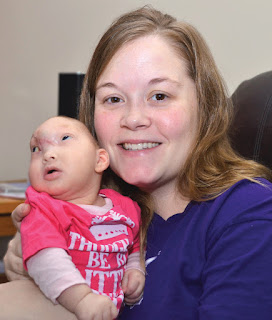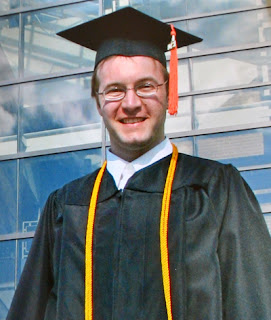Tiny, but fierce
If Layla Simpson cries and it sounds different than usual, her mom, Amanda, wonders if Layla will be alive the next day.
“I know that sounds dramatic but it’s kind of where we are at,” Amanda said.
After you learn about Layla, who was born with a very rare birth defect called an encephalocele and is an Angela Hospice patient, it doesn’t sound so dramatic anymore.
The 20-week ultrasound is where the Simpsons’ emotional roller-coaster began. That ultrasound, also known as the anatomy scan, is where many parents often get the first glimpse of their child, and photos of their profile to take home. Amanda and her husband, Mike, were only given pictures of Layla’s feet.
“I remember telling my husband that I was kind of irritated that the ultrasound tech hadn’t been chattier,” Amanda said.
After the ultrasound they went to meet with their doctor, thinking it would be a regular follow-up. He told them he wanted Amanda to see a specialist and they were recommended to Google “encephalocele” to learn more about it. The doctor didn’t have any information packets on it. So once in the parking lot they immediately went to Google.
“If you do happen to look up her condition it’s all very terrible,” Amanda said. “It rocked our world.”
Soon after that ultrasound, Amanda called the specialist to make an appointment, but there weren’t any openings for three weeks. This would be one of the many moments where Amanda would fight for her baby.
While on the phone with the doctor’s office, Amanda told them she couldn’t wait three weeks to find out what was wrong with Layla. An appointment was made for the following day instead, and the many doctors’ appointments began.
“Every time I would have a doctor’s appointment I would be scared that they wouldn’t hear the heartbeat anymore,” Amanda said. “I never walked away from another doctor’s appointment feeling like, ‘Oh wow, that was really cool.’
“I don’t even know how we made it,” she continued.
Luckily, Amanda and Mike had each other, a strong support system, their faith, and a few really wonderful doctors, some better than others.
 |
| Dr. Nadia Tremonti |
“Hospice is a very scary word for people who don’t know everything about it,” said Amanda, whose only previous hospice experience had been with her grandparents. She didn’t know anyone that used hospice as a service for a child.
Once at Children’s Hospital they met with three doctors and two OBs to go over all of her scans. This was where a plan for palliative care was put into place. At first, one of the doctors recommended she not have a C-section, but Amanda felt strongly about doing it because of how large Layla’s encephalocele was.
“I thought, ‘If she makes it to birth, why wouldn’t I take that extra step?’” Amanda said.
Amanda and Mike then had to make another hard decision: what did they want to do to prolong Layla’s life? Did they want her on machines? If so, how long? Amanda and Mike told the doctors they wanted to do whatever they could to help Layla breathe so they could say goodbye to her. The same doctor who didn’t want to do the C-section told them that could be traumatic for Layla, but Amanda and Mike stayed strong. When Layla was born she didn’t need any breathing machines or respirators; she came out kicking and screaming.
“I stayed strong and I’m so glad I did that because here we are,” Amanda said holding Layla, who at the time of our interview had just turned 12 weeks old and was making tons of noise. She also had on a pink shirt with a Shakespeare quote from A Midsummer’s Night Dream that couldn’t have been more appropriate: “And though she be but little, she is fierce.”
Two days after Layla was born she had surgery to remove the encephalocele, which took quite a bit of Layla’s brain. Amanda said they don’t know what functions that part of her brain held but they knew that her stem, which controls her breathing and heartbeat, was still intact. For now, they wait to see what happens. Layla can eat from a bottle but will she be able to feed herself someday? Will she be able to chew? Or walk? They don’t know.
“She’s obviously a miracle and a big blessing to us, but that’s probably the hardest part: there’s no idea what’s going to happen,” said Amanda, a self-described “planner.” “We’re not completely out of the woods.”
Now they have an Angela Hospice nurse and social worker that come to the house, and Layla is re-evaluated every 90 days by her doctor. Amanda said they probably won’t be able to take her off hospice until she’s at least a year old.
“I don’t quite understand everything about it,” Amanda said. “I don’t really get how she can be doing so well but we still talk about her passing.”
That unknown is also why they didn’t have a baby shower. And why Layla doesn’t really have a nursery. They hadn’t put money away for a crib because they didn’t think Layla would make it this long, and they didn’t want to have a nursery without a baby. She sleeps in a swing they have set up in the front room and all of her clothes are in two plastic dressers. But for now, Amanda and Mike will take every day they have with her, and cherish every second of it.
“You hear this (kind of) news and think, ‘Why me?’” Amanda said. “Now that she’s here I know why us. Because we can handle it, even though sometimes it feels like we’re not going to be able to. It’s really hard, but she’s here and she’s a miracle.”
GOOD NEWS
Since the time of this interview, Layla’s condition stabilized and she was able to sign off of hospice care. She’s now pursuing treatment under the care of her physician.
While it is not uncommon for patients to see some improvement in their condition once they begin hospice care, in 2016, about 5-percent of Angela Hospice patients actually improved or stabilized enough that they “graduated” from hospice care are were no longer hospice appropriate.




It takes 2 amazing people to produce a miracle. God chose Mike and Amanda for Layla because they are an amazing couple. Prayers always for your strong family.
ReplyDeleteThe strength of my daughter and son-in-law still amazes me. Their faith and strength is what keeps us all going. Layla could not be in better hands and as a grandma I could not be prouder.
ReplyDelete